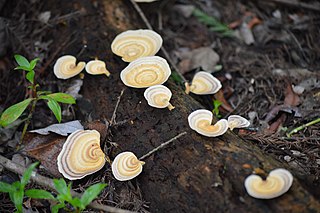
The Polyporaceae are a family of poroid fungi belonging to the Basidiomycota. The flesh of their fruit bodies varies from soft to very tough. Most members of this family have their hymenium in vertical pores on the underside of the caps, but some of them have gills or gill-like structures. Many species are brackets, but others have a definite stipe – for example, Polyporus badius.
Gastón Guzmán Huerta, a Mexican mycologist and anthropologist, was an authority on the genus Psilocybe.

Melanoleuca is a poorly known genus of saprotrophic mushrooms traditionally classified in the family Tricholomataceae. Most are small to medium sized, white, brown, ocher or gray with a cylindrical to subcylindrical stipe and white to pale yellowish gills. The basidiospores are ellipsoid and ornamented with amyloid warts. Melanoleuca is considered a difficult group to study due to their macroscopic similarities among species and the need of a thorough microscopic analysis to separate species. DNA studies have determined that this genus is closely related to Amanita and Pluteus and that it does not belong to the family Tricholomataceae.

The Albatrellaceae are a family of fungi in the order Russulales. The family contains 9 genera and more than 45 species.

Albatrellus is a genus of 19 species of mushroom-producing fungi in the family Albatrellaceae. Species are common in northern temperate forests, producing medium to large fleshy fruit bodies of various colors.

Albatrellus subrubescens is a species of polypore fungus in the family Albatrellaceae. The fruit bodies (mushrooms) of the fungus have whitish to pale buff-colored caps that can reach up to 14.5 cm (5.7 in) in diameter, and stems up to 7 cm (2.8 in) long and 2

The Phanerochaetaceae are a family of mostly crust fungi in the order Polyporales.

Ceriporia is a widely distributed genus of crust fungi.

Antrodiella is a genus of fungi in the family Steccherinaceae of the order Polyporales.

Arachnion is a genus of gasteroid fungi in the family Agaricaceae.

Hypochnicium is a genus of corticioid fungi in the family Meruliaceae. The genus was circumscribed by mycologist John Eriksson in 1958.

Irpex is a genus of corticioid fungi in the order Polyporales. Species produce fruit bodies that grow as a crust on the surface of dead hardwoods. The crust features an irpicioid spore-bearing surface, meaning it has irregular and flattened teeth. Irpex is distinguished from the similar genera Junghuhnia and Steccherinum by the simple septa found in the generative hyphae.

Microporellus is a genus of poroid fungi in the family Polyporaceae.

Skeletocutis is a genus of about 40 species of poroid fungi in the family Polyporaceae. The genus has a cosmopolitan distribution, although most species are found in the Northern Hemisphere. It causes a white rot in a diverse array of woody substrates, and the fruit bodies grow as a crust on the surface of the decaying wood. Sometimes the edges of the crust are turned outward to form rudimentary bracket-like caps.
Fevansia is a fungal genus in the family Albatrellaceae. A monotypic genus, it contains the single rare truffle-like species Fevansia aurantiaca, found in old-growth forests of Oregon. The name Fevansia honors Frank Evans of the North American Truffling Society, who collected the holotype specimen. Aurantiaca is Latin for "pale orange", referring to the color of the peridium.

Colus hirudinosus is a species of stinkhorn fungus (Gasteromycete) found in Asia, Australia, northern Africa, and southern Europe. The fruit body has a short, thick stalk that divides into several spongy, wrinkled, stalk-like, orange to red columns that are united at the top, thus forming a lattice. The spores are found within the gleba—a dark, olive-brown slime that coats the inside of the columns. Spores are spread by insects that are attracted by the fetid smell of the gleba, eat the spores, and pass them on to germinate elsewhere.
Albatrellus tianschanicus is a species of fungus in the family Albatrellaceae. It was originally described as Scutiger tianschanicus by Appollinaris Semenovich Bondartsev in 1960, and later transferred to the genus Albatrellus by Zdeněk Pouzar in 1960. Albatrellus henanensis, described in 1991, is a synonym.

Scutiger pes-caprae is a species of fungus in the family Albatrellaceae. It was first described officially as a species of Polyporus by Christian Hendrik Persoon in 1818. In recent decades, it was known most commonly as a species of Albatrellus until molecular research published by Canadian mycologist Serge Audet in 2010 revealed that it was more appropriate in an emended version of the genus Scutiger.
Albatrellus cantharellus is a species of fungus in the family Albatrellaceae. Originally described as a species of Polyporus by Curtis Gates Lloyd in 1915, it was transferred to the genus Albatrellus by Zdeněk Pouzar in 1972. It is found in Japan.

Albatrellus flettii is a species of fungus in the family Albatrellaceae. It was originally described in 1941 by Elizabeth Eaton Morse as Polyporus flettii, but this naming was invalid as it lacked a Latin description. Zdeněk Pouzar transferred it to Albatrellus in 1972. The species is found in western North America, where it grows on the ground in coniferous forests.














